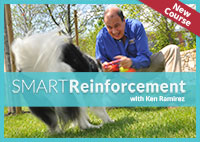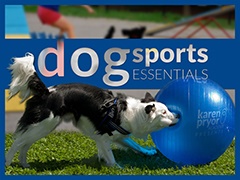An excerpt from Clicking with Your Dog: Step-by-Step in Pictures, by Peggy Tillman
Okay, so you've started clicker training your dog and you think that taking a class would be fun. It will take a little work on your part to make sure that the class you take meets your needs.
There are many choices. You can take a basic dog manners course. You can take a class directed at passing the American Kennel Club Canine Good Citizen test. Or you can take classes to get your dog an obedience, flyball, agility, or tracking title. Classes should be fun for both you and your dog.
First, decide what you want to get from a class. Then begin your search to find an instructor and class that will fulfill your needs and fit you and your dog.
Unlike other training methods, clicker training is not about your winning, or becoming alpha or top dog. It's about you both winning. You win by having a well-mannered canine friend. Your dog wins by understanding what makes you happy and by getting a reward. You both gain a great deal from the training process. You learn to communicate and bond with your dog. Your dog learns that he can control the consequences of his actions. You are not your dog's boss; you are his guardian.
If you are hoping to find a clicker training class, know that while clicking is becoming very popular, you may not always be able to find a qualified clicker instructor. This should not stop you from joining a class. Simply get permission from the instructor to use a clicker in class. Don't make it a big deal, just click and treat as needed.
You will, however, want to be certain to find a class that uses non-coercive methods (for both you and your dog). Not all classes are taught that way. Many classes advertise that they are gentle, humane, and use positive reinforcement. However, sometimes even these instructors believe that you must use "corrections" first, then follow with praise or a reward. This is not the way I believe dogs (or people) learn best. If you don't want to "correct" your dog while he's trying to learn, look for a class using the positive reinforcement part of operant conditioning.
If you have permission to click in a non-clicker class, it's important for the instructor to tell you what they will teach at the next class. This will allow you to introduce your dog to the new skill in a gradual, positive way. Use the class to practice and refine the skill in a distracting location. If your dog doesn't know the skill the class is working on, then work on a skill your dog knows. Train the new skill in small incremental steps at home.
The lists of questions below will help you determine whether a class is a good fit for you and your dog or not. Be sure that you interview and observe the person that will actually be teaching your class.
Questions to ask over the phone:
- What are the qualifications of the person that will teach the class?
- Does the instructor require a choke, check, or slip collar? (These are used to correct a dog, and are required in correction-based training classes. Avoid these classes.)
- What are their teaching philosophies/learning theories?
- What is the number of dogs in the class? (Most clicker trainers find that beginning classes are best limited to eight dogs.)
- Can you observe the class (without your dog)?
- What books and DVDs or videos do they recommend you read before the class? Read them and see if you agree with what they say.
- Does the instructor employ assistants? What are their qualifications? Will they be helping with the actual instructing?
- Are clickers allowed? If the answer is "yes," do they then try to convince you that you won't need one?
- Does the instructor ask you what you want to get out of the class, whether socialization, obedience, or a specific solution to a problem? Your instructor should be aware of your personal goals for training your dog.
- Do they encourage the entire family to come and work with your dog? Dog training affects everyone in the family.
Questions to ask yourself as you observe the class:
- Does the instructor tell the students to correct their dogs (using squirt bottles, leash pops, or loud commands)? Or do they show students how to respond without corrections?
- Does the instructor encourage the students to use a variety of reinforcements (food, toys, or play)?
- Do the students ask questions? Are they answered?
- Are all the dogs wearing the same kind of collar to correct their behavior? (This shows that the instructor is not helping students find individual solutions.)
- Are all the students doing the same things simultaneously (as a drill)? Each dog and handler should be encouraged to learn at their own rate.
- Is the instructor correcting people, or showing them a positive way to succeed?
- Do the dogs seem happy and relaxed, or are they nervous (licking, yawning, or barking)?
- Are the humans relaxed, smiling, and comfortable?
- Does the instructor see dogs as adversarial? Do they explain a dog's behavior as sneaky, deceitful, or stubborn?
- Does the instructor criticize other training methods, but doesn't explain why they don't work?
Find a certified trainer in your area!








Post new comment